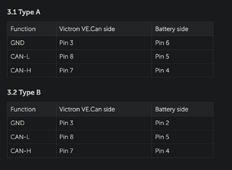I have a EG4 Communications Hub that I'm trying to get to communicate with Victron can bus. The hub is talking to the LiFePower4 battery just fine using RS485, but I can't get the battery/hub to show up in the Cerbo GX device list. The hub is set to Victron CAN protocol, and the hub is connected from the CAN1 INV port to the VE.Can on the Cerbo, using a cable that I made based on the diagram in the Victron cable manual... https://www.victronenergy.com/live/battery_compatibility:can-bus_bms-cable. I'm using the standard wiring convention for the RJ45 based on a number of diagrams on the Internet. The other VE.Can port is terminated.
Unless the convention that I'm using is backward, this should work unless I'm missing some setting. The manual is not much help, and what I can find on the Internet is about connecting the Cerbo to an EG4 LL battery.
Unless the convention that I'm using is backward, this should work unless I'm missing some setting. The manual is not much help, and what I can find on the Internet is about connecting the Cerbo to an EG4 LL battery.




